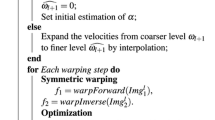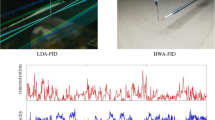Abstract
We introduce a new approach to diffusion-source estimation for quick identification of the unknown source, based on Taylor’s diffusion theory for turbulent transport of passive scalar from a fixed point source. In order to evaluate the method, we used planar laser-induced fluorescence to measure the concentration field of fluorescent dye in water flowing in a channel. We considered two kinds of datasets: basis data and observed data. The former is used to determine the basis functions characterizing the streamwise dependence of variances for three statistics: the mean concentration, root-mean-square (RMS) of fluctuations in the concentration, and RMS of the temporal gradient of the fluctuating concentration. Consistent with Taylor’s theory, we found that the lateral distribution of each statistic was basically Gaussian, and their standard deviations increased as a function of the square root of the distance from the emitted point. Based on these facts, a basis function can be formulated and expected to be valid for estimation of unknown sources. Source estimation was performed with the observed data, which corresponded to limited available information about the concentration from an unknown point source. We confirmed a good prediction accuracy of the proposed method with an averaged bias as small as the turbulent integral scale. Better precision was achieved by employing several statistics simultaneously. In this case, the standard deviation of the estimated source position was assessed at 14 % of the mean distance between the source and measurement points, after 100 source-estimate trials with different datasets. The methodology tested in this paper is expected to be applicable more general and complex environmental diffusion issues involving anisotropic turbulent dispersion, and space–time variable mainstream systems; but its versatility in such systems is currently under investigation.









Similar content being viewed by others
References
Fernando HJS, Lee SM, Anderson J, Princevac M, Pardyjak E, Grossman-Clarke S (2001) Urban fluid mechanics: air circulation and contaminant dispersion in cities. Environ Fluid Mech 1:107–164
Hayashi Y (2011) An analysis of the Great East Japan Earthquake by scientific information asymmetry models. In: Proceedings of the 8th international conference on innovation and management, pp 497–505
Yamashita S, Suzuki S (2013) Risk of thyroid cancer after the Fukushima Nuclear Power Plant accident. Respir Investig 51(3):128–133
Chino M, Kitabata H (1999) Development of the emergency system for radioactive source term estimation. JAERI-Data/Code 99-012. Japan Atomic Energy Research Institute (in Japanese)
Furuno A, Chino M, Yamazawa H (2006) Development of a source term estimation method for nuclear emergency by long-range atmospheric dispersion simulations. J At Energy Soc Jpn 5(3):229–240
Bagtzoglou AC, Dougherty DE, Tompson AFB (1992) Application of particle methods to reliable identification of groundwater pollution sources. Water Resour Manag 6:15–23
Ababou R, Bagtzoglou AC, Mallet A (2010) Anti-diffusion and source identification with the ‘RAW’ scheme: a particle-based censored random walk. Environ Fluid Mech 10:41–76
Islam M (1999) Application of a Gaussian plume model to determine the location of an unknown emission source. Water Soil Pollut 112:241–245
Ebrahimi M, Jahangirian A (2013) New analytical formulations for calculation of dispersion parameters of Gaussian model using parallel CFD. Environ Fluid Mech 13:125–144
U.S. Environmental Protection Agency (1977) User’s manual for single source (CRSTER) model. EPA 450/2-77-0.3. U.S. Environmental Protection Agency, Research Triangle Park
Weil JC, Brower RP (1984) An updated Gaussian plume model for tall stacks. J Air Pollut Control Assoc 34(8):818–827
Abe S, Kato S (2010) A study on improving the numerical stability in reverse simulation. J Environ Eng (Trans AIJ) 75(656):891–897 (in Japanese)
Abe S, Kato S, Hamba F, Kitazawa D (2012) Study on the dependence of reverse simulation for identifying a pollutant source on grid resolution and filter width in cavity flow. J Appl Math 2012:1–16
Hamba F, Abe S, Kitazawa D, Kato S (2012) Filtering for the inverse problem of convection–diffusion equation with a point source. J Phys Soc Jpn 81:1–8
Houweling S, Kaminski T, Dentener F, Lelieveld J, Heimann M (1999) Inverse modeling of methane sources and sinks using the adjoint of a global transport model. J Geophys Res Atmos 104:26137–26160
Caya A, Sun J, Snyder C (2005) A comparison between the 4DVAR and the ensemble Kalman filter techniques for radar data assimilation. Mon Weather Rev 133:3081–3094
Rao KS (2007) Source estimation methods for atmospheric dispersion. Atmos Environ 41:6964–6973
Sharan M, Issartel JP, Singh SK, Kumar P (2009) An inversion technique for the retrieval of single-point emissions from atmospheric concentration measurements. Proc R Soc Lond A. doi:10.1098/rspa.2008.0402
Hinze JO (1959) Turbulence. McGraw-Hill, New York, pp 324–352
McComb WD (1990) The physics of fluid turbulence. Oxford University Press, Oxford, pp 437–441
Davidson PA (2004) Turbulence: an introduction for scientists and engineers. Oxford University Press, Oxford, pp 273–276
Kosugi K, Makita H, Haniu H (2014) Experimental investigation on turbulent diffusion phenomena of meandering plume in the quasi-isotropic turbulent field (variation of mean concentration properties for turbulent Reynolds numbers). Trans JSME 80(810):1–14 (in Japanese)
Webster DR (2007) Structure of turbulent chemical plumes. In: Trace chemical sensing of explosives. Wiley, New York, pp 109–129
Motozawa M, Kurosawa T, Otsuki T, Iwamoto K, Ando H, Senda T, Kawaguchi Y (2012) PLIF measurement of turbulent diffusion in drag-reducing flow with dosed polymer solution from a wall. J Therm Sci Technol 7:272–287
Moser RD, Kim J, Mansour NN (1999) Direct numerical simulation of turbulent channel flow up to \({\rm {Re}}_{\tau } = 590\). Phys Fluids 11:943–945
Bradley EF, Antonia RA, Chambers AJ (1981) Turbulence Reynolds number and the turbulent kinetic energy balance in the atmospheric surface layer. Bound Layer Meteorol 21:183–197
Webster DR, Rahman S, Dasi LP (2003) Laser-induced fluorescence measurements of a turbulent plume. J Eng Mech 129:1130–1137
Crimald JP (2008) Planar laser induced fluorescence in aqueous flows. Exp Fluids 44:851–863
Pope SB (2000) Turbulent flows. Cambridge University Press, Cambridge, pp 305–308
Acknowledgments
We express our appreciation to Messrs. Shotaro Hatsutani and Junichiro Hasegawa, who were master’s students at Tokyo University of Science, for their support in experiments and discussions.
Author information
Authors and Affiliations
Corresponding author
Rights and permissions
About this article
Cite this article
Tsukahara, T., Oyagi, K. & Kawaguchi, Y. Estimation method to identify scalar point source in turbulent flow based on Taylor’s diffusion theory. Environ Fluid Mech 16, 521–537 (2016). https://doi.org/10.1007/s10652-015-9436-x
Received:
Accepted:
Published:
Issue Date:
DOI: https://doi.org/10.1007/s10652-015-9436-x




